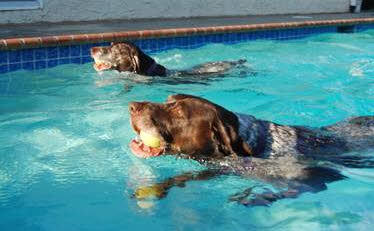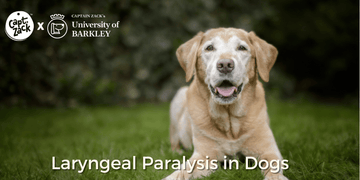
Most of us know the larynx is commonly known as the voice box and is located in the throat. We know that laryngitis is a condition where one cannot speak but other than that, the larynx does not get much thought. It is a vastly under-appreciated organ. The larynx is not just where sound comes from; it is more importantly the cap of respiratory tubing. The larynx closes the respiratory tract off while we eat and drink so that we do not inhale our food. If we need to take a deep breath, the muscles of the larynx expand and open for us. The larynx is the guardian of the airways, keeping whatever we want to swallow out and directing air in.
Laryngeal paralysis results when the abductor muscles of the larynx cannot work properly. This means no expanding and opening of the larynx for a deep breath; the laryngeal folds simply flop weakly and flaccidly. In other words, when you need a deep breath, you don't get one. This can create tremendous anxiety (imagine attempting to take a deep breath and finding that you simply cannot). Anxiety leads to more rapid breathing and more distress. A respiratory crisis from the partial obstruction can emerge, creating an emergency and even death.
Laryngeal paralysis does not come about suddenly. For most dogs there is a fairly long history of panting, easily tiring on walks, or loud breathing. Ideally, the diagnosis can be made before the condition progresses to an emergency.
Dogs with laryngeal paralysis demonstrate some or all of the following signs:
- Excess panting
- Exercise intolerance
- Voice change
- Loud breathing sounds
- Respiratory gasping or distress
The usual patient is an older, large breed dog; the most commonly affected breed is the Labrador retriever. The condition can occur in cats but is rare. The Bouvier des Flandres has a hereditary form of laryngeal paralysis that is able to affect young dogs. Other similarly affected breeds include: Siberian Husky, Great Pyrenees, bull terrier, and Dalmatian. These dogs are said to have congenital laryngeal paralysis, while older dogs that develop theirs in old age are said to have acquired laryngeal paralysis.
Is Laryngeal Paralysis Part of a Bigger Neurologic Problem?
The time for ambiguity regarding this question has passed and the answer is a definite yes. Laryngeal paralysis is now considered to be the first symptom of a much more pervasive neurologic weakness, hence the new name of the condition, "Geriatric Onset Laryngeal Paralysis and Polyneuropathy." In time, the leg muscles will become weak and the esophagus (the tube that carries food from the throat to the stomach) will become flaccid and dilated in a condition called megaesophagus. The good news is that the average patient with acquired laryngeal paralysis is at least 10 years old and the progression of the neurologic weakness is fairly slow. This means many patients will live their normal lifespan before further neurologic weakness becomes a problem. We can still say, however, that dogs with laryngeal paralysis are 21 times more likely to develop a megaesophagus than are dogs without it.
It's been suggested that hypothyroidism may be a cause of laryngeal paralysis. In fact, it is not. Hypothyroidism is associated with other neuropathies that could complicate the polyneuropathy of which laryngeal paralysis is a part. This means hypothyroidism should be identified and treated, but while improvement in weakness etc. may be seen, the laryngeal paralysis will not reverse with thyroid hormone supplementation.
Making the Diagnosis
To determine if a dog has laryngeal paralysis, the larynx must be examined under sedation. The level of sedation must be heavy enough to allow the larynx to be visualized but light enough for the patient to be taking some deep breaths. If the sedation is too deep for the diagnosis to be obvious, a respiratory stimulant called Dopram® (doxapram hydrochloride) is given intravenously to stimulate several deep breaths so that the function of the larynx is clear. In a normal larynx, the arytenoids cartilages are seen to open and close widely. In a paralyzed larynx they just sit there limply while the patient breathes deeply.
If the patient is having a respiratory crisis when seeing the veterinarian, this diagnostic test can easily be followed by intubation, inserting a breathing tube down the patient’s throat. This relieves the upper airway obstruction and the patient can breathe normally; unfortunately, sedation must be maintained to keep the tube in place.
A newer technique of visualizing the larynx involves threading an endoscope down the patient’s nostril. This is tricky but the benefit is that sedation is not required. The downside is that specialized equipment is needed and the patient may not be cooperative.
Additional Testing
There are some additional tests that are helpful in evaluating the patient with laryngeal paralysis. Chest radiographs are important in ruling out aspiration pneumonia (from inhaling food material through the non-functional larynx), megaesophagus (which we have mentioned tremendously complicates a laryngeal paralysis case), and obvious tumor spread. Radiographs of the throat to rule out obvious throat tumor are also helpful. Complete blood testing including thyroid tests should also be included in the work-up.
Conservative Treatment
Treatment of laryngeal paralysis is most likely going to require surgery but not everyone is ready or able to provide a surgical solution for their dog. Here are some tips for non-surgical management:
- Change from collar to harness to avoid pressure on the larynx.
- Avoid heat or other situations where the dog might pant.
- Reduce activity (also so as to reduce panting)
- An anti-anxiety medication called Doxepin has been used to palliate laryngeal paralysis in patients where surgery is not an option. Studies assessing whether this is actually a meaningful treatment are on-going but it may be worth a try.
The Crisis
If laryngeal paralysis is not treated, a respiratory crisis can emerge. In this situation, the patient attempts to breathe deeply and simply cannot, creating a viscious cycle of anxiety and respiratory attempts. The laryngeal folds become swollen, making the throat obstruction still worse. The patient’s gums become bluish in color from lack of oxygen and the patient begins to overheat. For reasons that remain unclear, fluid begins to flood the lungs and the patient begins to drown (as if the laryngeal obstruction wasn’t lethal enough).
The patient must be sedated, intubated, and cooled down with water in order to survive. As soon as intubation is in place, the patient can breathe normally, oxygen can be given, and the crisis can be curtailed if it has not progressed too far.
Of course, eventually the patient will have to wake up and be able to survive without medical equipment. Corticosteroids can be used to reduce the swelling but ideally one of several surgical solutions is needed.
Surgical Solutions
The goal of surgery, whichever technique is used, is to relieve the airway obstruction permanently while maintaining the original function of the larynx (protection of the airways).
Laryngeal Tieback (also called Lateralization Surgery)
This has probably become the most commonly performed surgery for laryngeal paralysis. It involves placing a couple of sutures in such a way as to pull one of the arytenoid cartilages backward. By repositioning one of the arytenoids the opening of the larynx is made larger. The chief complication stems is that only a few millimeters of position change in the arytenoids are needed. If the cartilage is moved too much, the larynx cannot properly close and aspiration pneumonia becomes a substantial risk. Commonly these patients have a persistent cough after eating or drinking. This surgery has been associated with a 14 percent postoperative mortality rate. (Years ago, both arytenoids were tied back to create a still larger larynx but tying off both cartilages in this way was associated with a 67% mortality rate so it is no longer done.)
Partial Arytenoidectomy
Another surgical technique involves only biting out one vocal fold and also biting out the arytenoids cartilage on the same side. There is more bleeding with this technique and a tracheostomy becomes more desirable. Surgeries involving removing part of the larynx have been associated with a 30% mortality rate in laryngeal paralysis patients.
Ventriculocordectomy (De-Barking)
De-barking surgery is generally thought of as a surgical solution to a behavioral problem but it is also a fair treatment for laryngeal paralysis. The usual method involves extending a long “biting” forcep down the throat and biting out the vocal folds. Obviously anesthesia is needed to do this and the fact that the surgical area is the larynx makes normal intubation for anesthesia impossible. This means either using injectable anesthesia or placing a tracheostomy (cutting a hole in the throat lower down) and intubating through that.
Removing the vocal folds also removes the patient’s voice, reducing barking to a whisper. The hole created by the absence of the vocal folds makes for a larger airway opening and is generally large enough to relieve the obstruction. Complications of this surgery include swelling and bleeding (which can cause obstruction in themselves, though, if a tracheostomy is placed any such obstruction is bypassed), and regrowth of a webbing of vocal tissue. An alternative technique involves approaching the larynx from the outside of the throat instead of down the mouth. This method is more difficult and time consuming but has less chance of developing webbing. A tracheostomy, if any, is allowed to heal closed.
Castellation
In this surgery, a square of the thyroid cartilage is cut (similar to a castle’s turret's square behind which an archer might hide). This square is moved forward and reattached to create a wider laryngeal opening. A tracheostomy is frequently needed to protect from swelling.
Post-Operative Considerations
There are some special concerns after laryngeal surgery regardless of the procedure:
- The patient must be restricted from barking for 2-3 weeks. Tranquilizers may be needed to effect this.
- Expect a reduced volume in the patient's bark.
- Some gagging and coughing is normal during eating and drinking. This tends to reduce or resolve with time.
- No swimming ever! The patient's airway protection is compromised with laryngeal surgery and many dogs will swim with their mouths open. The risk of water aspiration is too great.
Aspiration Pneumonia
While only about 10 percent of dogs being evaluated for surgical correction of laryngeal paralysis already have aspiration pneumonia, nearly 25% will develop it at some point. Pneumonia is always potentially life-threatening and aspiration pneumonia is particularly difficult to clear since it involves large contaminated food particles in the lung. Broad spectrum antibiotics, fluid therapy, and physical therapy are important tools but, sadly, the underlying condition that led to the original aspiration pneumonia is likely to produce future episodes.
382614.1637145784
The content of this site is owned by Veterinary Information Network (VIN®), and its reproduction and distribution may only be done with VIN®'s express permission.
The information contained here is for general purposes only and is not a substitute for advice from your veterinarian. Any reliance you place on such information is strictly at your own risk.





